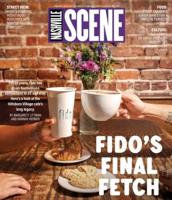Only a visionary would look at derelict buildings with a blood-red past and see a future in nature lover's green. That was Stephen McRedmond.
The Neuhoff meat-packing plant witnessed the slaughter of 14,000 animals a week before its closure in 1977. The 700,000-square-foot complex — that's three Super-Walmarts — dates to 1906 and stands by the Cumberland six blocks north of the Metro Courthouse. My first visit to the 17-acre site was not long after the property came to the McRedmond family in 1998.
By then the structures were pretty much shells, albeit still manifesting their sturdy German heritage. On that cold, misty day, my dog coursed joyously through vast, tile-lined halls, scenting bloody ghosts. I stumbled over heaps of unused bacon wrappers and softball trophies won by workers past.
Stephen McRedmond saw beyond relics of the killing industry. The less imaginative — and less brave — among us, aspiring to quick profits, would've called in the bulldozers. But McRedmond — I can only think of him as Stephen — was determined to reclaim Neuhoff.
As he saw it, architecture like this wouldn't ever be built again. He had the chance not merely to save it, but make it a locus for creative practices. Stephen painted for me a picture of a village focused on the arts and ecology, with mixed-income housing, perhaps a restaurant and brewery, and a research center devoted to the river and water-quality conservation.
He didn't quite get there. Stephen's terrible and untimely death last week — shot by a nephew who then turned his gun on himself, over what has been described as a legal dispute — has left all those who care about our city's nature and culture reeling. But in the time he had, he did a lot.
A generous, gregarious teddy bear of a man, quick to laugh but brimming with infectious enthusiasm for his causes, Stephen had definite ideas — and ideals — about Neuhoff's reclamation. "We want it all to be very organic," he told the Scene in 2002. By that he meant growing the site through collaboration between everyone from the neighborhood activist to the global-scale thinker. And he wanted the process to be as rewarding as the product.
The first step — after rubbish removal — was NCAP. In 1999, Stephen founded the Nashville Cultural Arts Project with his sister, Anita Sheridan; two longtime friends, Mel Chin, a renowned conceptual artist, and filmmaker Helen Nagge; and Kathy Grainger, the decades-long CPA for his family firm McRedmond Bros., a manufacturer of farm feed and grease. The nonprofit's goal was to bring together new ideas in art, architecture and environmentalism to reinvent and revitalize — not just Neuhoff, but the neighborhood of East Germantown and maybe even Nashville itself.
In 2000 the renovation of the "pink building" provided space to stage events. Drawing on Chin's wide-ranging contacts in the international design community, the NCAP team brought to Neuhoff a succession of cutting-edge architects, urban designers, artists, curators and theorists of the arts to present their work. But these "Outta Site!" programs were a mere part of Stephen's purpose.
"Stephen thought if young, avant-garde architects — he couldn't afford established stars — saw Neuhoff, they might want to do a project there," says Gary Gaston, design director at the Nashville Civic Design Center. "And they all fell in love with the site — and with Stephen's energy."
The first participant, Los Angeles-based architect Neil Denari, designed a sustainable master plan for Neuhoff. Another speaker, Greg Pasquarelli of New York's SHoP Architects, designed Neuhoff's first new building, a bold remake of the former animal holding pen.
The Great Recession slowed progress, but Stephen kept pushing. He installed a 2,600-square-foot green roof employing plant types from central Tennessee's endangered cedar glades. He designed the "Poet's Garden," a small outdoor performance space paved and planted within an old storage container. Neuhoff also became a magnet for other arts entities: the Nashville Jazz Workshop, Actor's Bridge Ensemble and the Butcher Shoppe recording studio of John Prine and David Ferguson.
Perhaps more transformative than specific build-outs, however, was Stephen's capacity to inspire.
"When I came to Nashville just out of architecture school, I felt, like most young designers, that you had to go to New York to do anything interesting," Gaston explains. "But then I met Stephen. He told me his plans for Neuhoff, invited me to get involved, made me want to stay here. Stephen showed me that you could start in Nashville and engage the world."
If Neuhoff was Stephen's yin, the yang was the McRedmond farm. His ancestors settled there in the mid-19th century, and over the years it became a family compound. Stephen grew up there and returned when he came home from Boston in 1978. In the ensuing decades, he planted hundreds of trees and worked relentlessly to clean the waters of Mill Creek, which runs through the 70-acre site. With his partner, Matthew Cushing, he designed and built a house there.
Thus it was supremely fitting that Stephen's family and friends gathered at the farm last week to remember him. They told moving and funny stories, sang songs, and pledged to continue his vision.
But the best tribute to Stephen wasn't by word or sound. During the service —beyond the crowd, past the coffin, through the still leafless branches of a massive oak — a great blue heron could be seen down the slope by the stream. It beat its huge wings, then lifted, flying low over the water.
For a moment, at least, Stephen McRedmond's vision was accomplished.
Email editor@nashvillescene.com.




